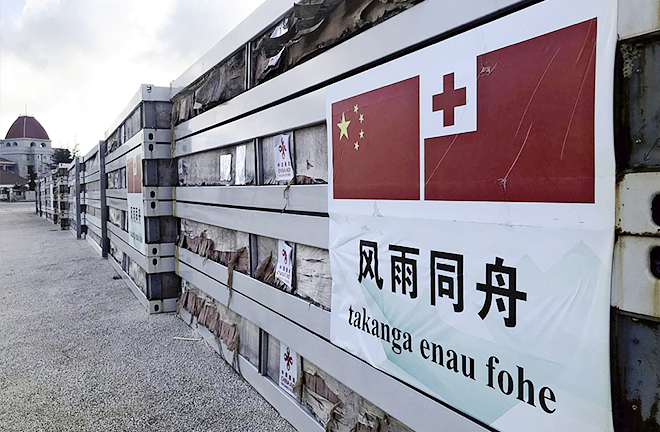Chinese modernization globally relevant

Pictured above are containers of relief supplies from China at a pier in Tongatapu, Tonga, on Jan. 9, about one year following a catastrophic volcanic eruption in the country. Building a human community with a shared future is the overarching goal of Chinese modernization. Photo: CFP
At a recent international forum on “Chinese Path to Modernization and Global Community of Shared Future” in Beijing, academics noted that Chinese modernization has not only distinctive Chinese characteristics and contemporary features, but also universal value and global significance.
Global significance
At the forum, Wu Zhicheng, deputy director of the Institute of International Strategy under the Party School of the Central Committee of CPC (National Academy of Governance), summarized the global implications of Chinese modernization, including the overarching goal to build a human community with a shared future, the spiritual bond of humanity’s shared values, basic principles of peaceful development and cooperation for mutual benefit, governance features of shared growth and common prosperity through discussion and collaboration, and the international path of fostering a new type of international relations.
China regards pursuing peaceful development as an important underpinning for realizing modernization, and stands firmly against all forms of hegemonism, power politics, and the Cold War mentality. As such, it has creatively proposed and actively practiced the Global Development Initiative, the Global Security Initiative, and the Global Civilization Initiative, playing a significant role in maintaining world peace and development.
The three major global initiatives put forward by President Xi Jinping have pointed the direction for the world to jointly build a human community with a shared future, said Mushahid Sayed, chairman of Pakistan’s Senate Defence Committee. Emphasizing people-centered economic development and following the path of cooperation for mutual benefit, China has provided new plans and valuable experiences for many developing nations to modernize themselves, while making active contributions to protecting international fairness and justice, and standing against power politics, Sayed said.
Rooted in Chinese culture
Chinese modernization is deeply rooted in fine traditional Chinese culture, and draws inspiration from all of human civilization’s outstanding achievements. It inspires the world by its understanding of the relationship between traditional and modern civilization.
Wen Yang, a research fellow from the China Institute at Fudan University, said that Chinese modernization and the building of a human community with a shared future are consistent with Chinese perspectives on the universe, the world, society, and morality, which took shape over the long historical course of the Chinese nation.
The new form of human advancement created out of Chinese modernization is committed to maintaining harmony between humanity and nature, and values both material and ecological advancement. As Guseletov Boris, a chief researcher from the Institute of Social and Political Science at the Russian Academy of Sciences and senior researcher from the academy’s Institute of Europe, pointed out, an important feature of the Chinese model of modernization is ensuring harmony between humanity and nature. “China is making great efforts to develop a low-carbon economy in order to reduce carbon dioxide emissions into the atmosphere,” he said.
Expanding paths to modernization
Chinese modernization dispels the myth that modernization equals Westernization and presents another picture of modernization. It expands the channels for developing countries to achieve modernization and provides a Chinese solution to aid the exploration of a better social system for humanity.
Einar Tangen, a senior fellow at the Taihe Institute headquartered in Beijing, said the success of China’s reform and opening up has proved that the Chinese path to modernization is suited to the nation’s actual conditions. A country’s modernization path depends on its historical traditions, social system, and development model, so different national conditions can lead to different paths to modernization.
Since reform and opening up, the Chinese government has lifted about 800 million people out of poverty, which has not only benefited China, but is also of much referential value to other countries in their attempts to reduce poverty and improve people’s living standards, said Jean-Christophe Iseux von Pfetten, president of the Royal Institute of East-West Strategic Studies in the United Kingdom. He added that the remarkable achievement is also powerful proof of Chinese modernization advancing China’s social development and actively safeguarding human rights.
Mohammed Saqib, founder and secretary general of the Delhi-based India-China Economic and Cultural Council, said that one of China’s most significant aspects of modernization is its emphasis on a human community with a shared future. Upholding true multilateralism and the shared values of humanity, the Chinese path to modernization represents an innovative and forward-thinking approach to development that seeks to balance economic progress with social and environmental sustainability. It provides useful references for India’s modernization drive, Saqib said.
The symposium was co-hosted by China Foreign Languages Publishing Administration and China Institute for Innovation and Development Strategy.
Edited by CHEN MIRONG
